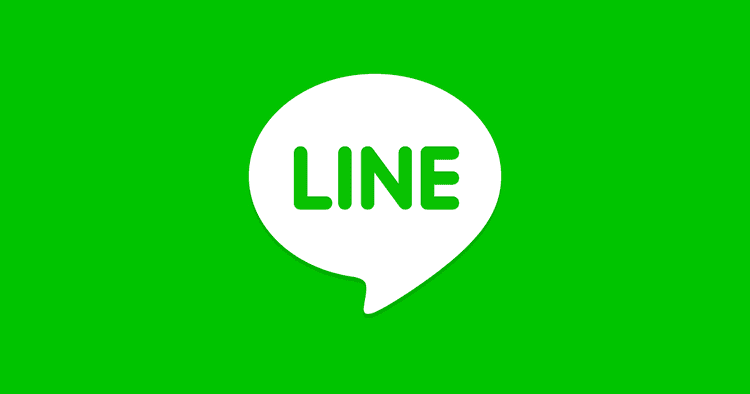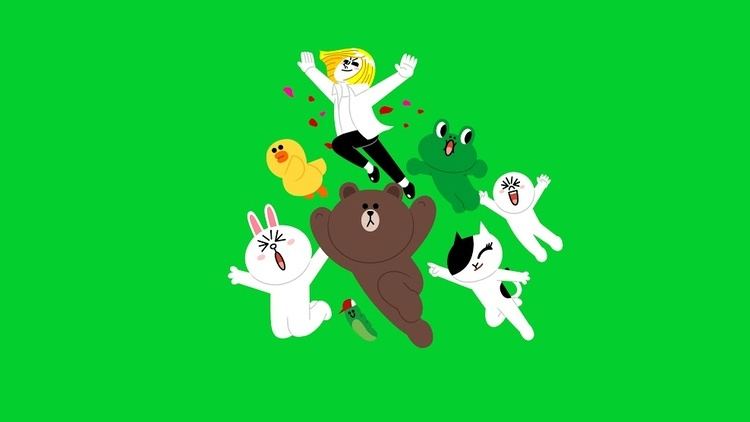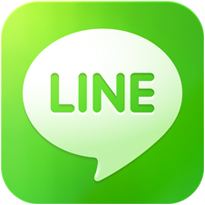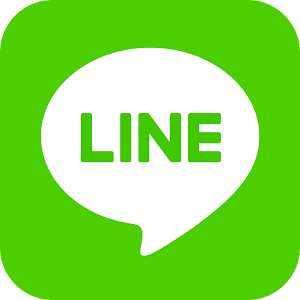 | ||
Initial release March 2011; 6 years ago (2011-03) iOS 7.0.0 / 26 January 2017; 51 days ago (2017-01-26) Android 7.0.1 / 23 January 2017; 54 days ago (2017-01-23) BlackBerry 3.3.8 / 21 October 2016; 4 months ago (2016-10-21) Firefox OS 1.7.3 / 11 May 2015; 21 months ago (2015-05-11) | ||
Line (styled as LINE) is a freeware app for instant communications on electronic devices such as smartphones, tablet computers and personal computers. Line users exchange texts, images, video and audio, and conduct free VoIP conversations and video conferences. Today the popular messaging service is operated by Line Corporation, the Japanese arm of Naver Corporation.
Contents
- Using line messaging app to explain line
- History
- Market share
- Features
- Stickers
- Games
- Line Friends
- Stores
- Limitations
- Security
- Censorship
- Line Offline
- Characters
- Theme Songs
- In popular culture
- References

Line first launched in Japan in 2011, reaching 100 million users within eighteen months and 200 million users only six months later. Line became Japan's largest social network in 2013. In October 2014 Line announced that it had attracted 560 million users worldwide with 170 million active user accounts. In February 2015, it announced the 600 million users mark had been passed and 700 million were expected by the end of the year.

Line was originally developed as a mobile application for Android and iOS smartphones. The service has since expanded to BlackBerry OS (August 2012), Nokia Asha (Asia and Oceania, March 2013), Windows Phone (July 2013), Firefox OS (February 2014), iOS tablets (October 2014), and as a Chrome Browser Application (via the Chrome Web Store). At one point Line was available as a website (non-browser-app), but that has been discontinued. The application also exists in versions for laptop and desktop computers using the Microsoft Windows and macOS platforms.

Using line messaging app to explain line
History

Line began as a disaster response. In March 2011 the Tōhoku earthquake damaged Japan's telecommunications infrastructure nationwide, obliging employees at NHN Japan, a unit of South Korea's NHN Corporation, to rely on Internet-based resources to communicate. The company's engineers developed Line to facilitate this, and the company released their app for public use in June.
The application proved hugely popular and by late October Line experienced an unexpected server overload. After concluding that the scalability process needed to be improved, NHN Japan chose to adopt HBase as the primary storage for user profiles, contacts, and groups. Within eighteen months of its release Line reached 100 million users; six months later it reached 200 million and on November 25, 2013 is used by 300 million users.
On July 3, 2012, NHN Japan announced the new Line features Home and Timeline. The features allowed users to share recent personal developments to a community of contacts in real-time, similar to the status updates in social networking services such as Facebook.
On 6 February 2013, the success of Line led NHN Japan to announce a new spinoff company named Line Corporation. Line Corporation, based in Japan, continues to develop Internet resources such as Line, the Naver Japan search portal, and the Livedoor ISP and blog platform. Games, including those for the Line Game brand, remain under the auspices of Hangame Japan. A new joint venture named Line Plus Corporation, also based in Japan, develops overseas markets. At launch the majority of Line Plus shares were held by the newly created Line Corporation (60%) with the remaining shares (40%) held by its Korean parent NHN Corporation.
Market share
Line began in summer 2011 as a communication system for NHN Japan employees, then saw explosive growth when released to the public in June of that year. By 18 January 2013, Line had been downloaded 100 million times worldwide. The number expanded to 140 million by early July 2013 and to 200 million by July 21. As of June 2016, Japan claimed 68 million users while Thailand had 33 million. As of February 2014, Indonesia had 20 million users, Taiwan 17 million, while India and Spain had 16 million each. NHN company representatives announced plans to reach 300 million by further expansion in East Asia, Spain, and Chile. In April 2014, Naver announced that Line had reached 400 million worldwide users.
Features
Line is an application that works on multiple platforms and has access via multiple personal computers (Windows or macOS). The application will also give an option of address book syncing. This application also has a feature to add friends through the use of QR codes, by line id, and by shaking phones simultaneously. The application has a direct pop-out message box for reading and replying to make it easy for users to communicate. It also can share photos, videos and music with other users, send current or any specific location, voice audio, emojis, stickers and emoticons to friends. User can see a real-time confirmation when messages are sent and received or use a hidden chat feature, which can hide and delete a chat history after a time set by the user. The application also makes free voice and video calls. Users can also chat and share media in a group by creating and joining groups up to 500 people. Chats also provide bulletin boards on which you can post, like, and comment. This application also has timeline and homepage features that allow users to post pictures, text and stickers on their homepages. Users can also change their Line theme to the theme Line provides in the theme shop for free or users can buy other famous cartoon characters they like. Line also has a feature, called a Snap movie, that users can use to record a stop motion video and add in provided background music. Line also has the possibility to create "Hidden Chats", giving the user the ability to set a timer after which messages disappear from both involved devices and Line servers.
In January 2015, Line Taxi was released in Tokyo as a competitor to Uber. Line launched a new android app called "Popcorn buzz" in June 2015. The app facilitates group calls with up to 200 members. In June a new Emoji keyboard was also released for iOS devices, which provides a Line-like experience with the possibility to add stickers. In September 2015 a new Android Launcher was released on the Play Store, helping the company to promote its own services through the new user interface.
Stickers
Line features a Sticker Shop where users are able to purchase virtual stickers depicting original and well-known characters. The stickers are used during chat sessions between users and act as large sized emoji. Users can purchase stickers as gifts, with many stickers available as free downloads, depending on country availability. Purchased stickers are attached to an account and can be used on other platforms. New sticker sets are released weekly. Line's message stickers feature original characters as well as a number of popular manga, anime and gaming characters, movie tie-ins, and characters from Disney properties such as Pixar. Some sticker sets, such as those that celebrate special events like the 2012 Summer Olympics, are released for only a limited time. Default stickers were designed by South Korean artist, Kang Byung-Mok, also known as illustrator Mogi.
There are over 1 billion stickers sent by worldwide users on a daily basis.
Games
NHN Japan created LINE GAME in 2011. Only those with an account to the Line application can install and play Line Game games. Players can connect with friends, send and accept items, and earn friend points. The game range includes puzzles, match-three, side-scroller, musical performance, simulation, battle, and spot-the-difference games. Line Corporation announced its games had been downloaded 200 million times worldwide.
Line Friends
Line Friends are featured characters that are shown in stickers of the application. They include Brown, Cony, Sally, James, Moon, Boss, Jessica, Edward, Leonard, Choco, Pangyo and Rangers.
Stores
There are physical stores in Japan, South Korea, China, and Taiwan and a Korean online store to purchase LINE Friends merchandise. Occasionally, LINE will have pop up or temporary stores globally.
Limitations
Line accounts can be accessed on only one mobile device (running the app version), plus one personal computer (running the version for those). Additional mobile devices can install the app but require different mobile numbers or e-mail addresses for the Line account.
Security
In August 2013, it was possible to intercept a Line chat session at the network level using packet capture software and to reconstruct it on a PC. Messages were sent in clear text to Line’s server when on cellular data but encrypted when using Wi-Fi most of the time.
Until February 2016, it was also possible to "clone" an iPhone from a backup, and then use the "cloned" iPhone to access the same Line account as used by the original iPhone. This loophole was widely rumored (but never proven) to have been used to intercept Line messages between the popular Japanese television personality Becky and her married romantic partner Enon Kawatani; the intercepted messages were published in the magazine Shukan Bunshun and led to the temporary suspension of Becky's television career.
In July 2016, Line Corporation turned on end-to-end encryption by default for all Line users. It had earlier been available as an opt-in feature since October 2015. The app uses the ECDH protocol for client-to-client encryption. In August 2016, Line expanded its end-to-end encryption to also encompass its group chats, voice calls and video calls.
Censorship
In China, Line suppresses content to conform with government censorship. Analysis by Citizen Lab showed that accounts registered with Chinese phone numbers download a list of banned words that cannot be sent or received through Line. The banned words reflect the usual topics proscribed by Chinese officials, such as the Tiananmen Square protests of 1989 and controversies about Tibet and Hong Kong.
Line publicly confirmed the practice in December 2013:
LINE had to conform to local regulations during its expansion into mainland China, and as a result the Chinese version of LINE, "LIANWO," was developed. The details of the system are kept private, and there are no plans to release them to the public.
In Indonesia, Line has responded to pressure from the Indonesian Communication and Information Ministry to remove emojis and stickers it believes make reference to homosexuality, for example the emoji "two men holding hands". Line issued a public statement on the issue: "Line regrets the incidents of some stickers which are considered sensitive by many people. We ask for your understanding because at the moment we are working on this issue to remove the stickers".
Line Offline
Line Offline is an animated series created by Shogakukan Productions, based on salaryman characters working at "Line Corporation". All 114 episodes last about three minutes. The series was aired from January 8, 2013, to October 1, 2013.
The episodes of Line Offline are not connected to each other. The idea behind the series is to represent the ordinary life of company employees (in this case Line's employees, that's why the series is called "Line Offline"), in which every small problem could lead to weird and funny situations that require some effort in order to restore the status quo.
Most characters from Line Offline are part of Line's universe (the characters who are shown in the animated series are also Line Friends, and they can be seen by users in Line Messaging App and used as emoticons).
Characters
Moon (voiced by Toshiyuki Morikawa) is a manjū-shaped-headed man who loves the moon. His interest is playing video games. He sometimes tricks his friends when he is bored. His father is an adventurer.
Cony (voiced by Aki Kanada) is a rabbit with a pleasant personality. She likes to go on a diet.
Brown is a bear who likes salmon a lot. He is silent, and has a crush on Cony. He becomes scary when he gets angry, and notes appears when he feels good.
James (voiced by Yūto Kazama) is a narcissist with long, blonde hair. He is obsessed with his appearance, and is afraid of high places.
Sally (voiced by Atsuko Enomoto) is a chick who usually helps her friends. She often stays in the windmill tree hollow in the park. She likes karaoke.
Jessica (voice by Sachi Kokuryū) is a cat who is knowledgeable about fashion and loves to cook a lot. She is Cony's best friend.
Boss/Mister (voiced by Nobuo Tobita) is an almost completely bald middle-aged man with glasses. He appears as many different identities in every episode.
Leonard (voiced by Megumi Han) is a little frog boy that looks up to Moon. He refers to Moon as an "elder brother". ("Longing For")
Edward is a green worm with a cap who often stays by Sally's side.
Cob Taro (voiced by Nobuo Tobita) is a cobra with a Mohawk hairstyle and an eye patch that escaped from the zoo and now has a part-time job at the burger shop.
Dorothy (voiced by Chie Kōjiro) is a hen who likes to take gossips. Cony fears her.
Mr. Kinoko (voiced by Mitsuru Ogata) is a beaver who owns a mushroom dish restaurant and can cook mushroom dishes very well. Kinoko is the Japanese word for mushrooms.
Theme Songs
In popular culture
On November 20, 2012, Line was shown in Far East Movement's music video, featuring Sidney Samson, for the song "Change Your Life". DJ Virman is seen chatting with Sidney Samson at the middle of the music video.
On December 16, 2012, the Line application was shown in rap artist Big Sean's music video for the song "Guap".
On May 16, 2014, Warner Music Italy released the music video for Italian singer Annalisa's "Sento solo il presente", in which the recording artist is seen using the Line application at the beginning of the video.
In 2014, the LINE app featured in Cycle 21 of America's Next Top Model.
